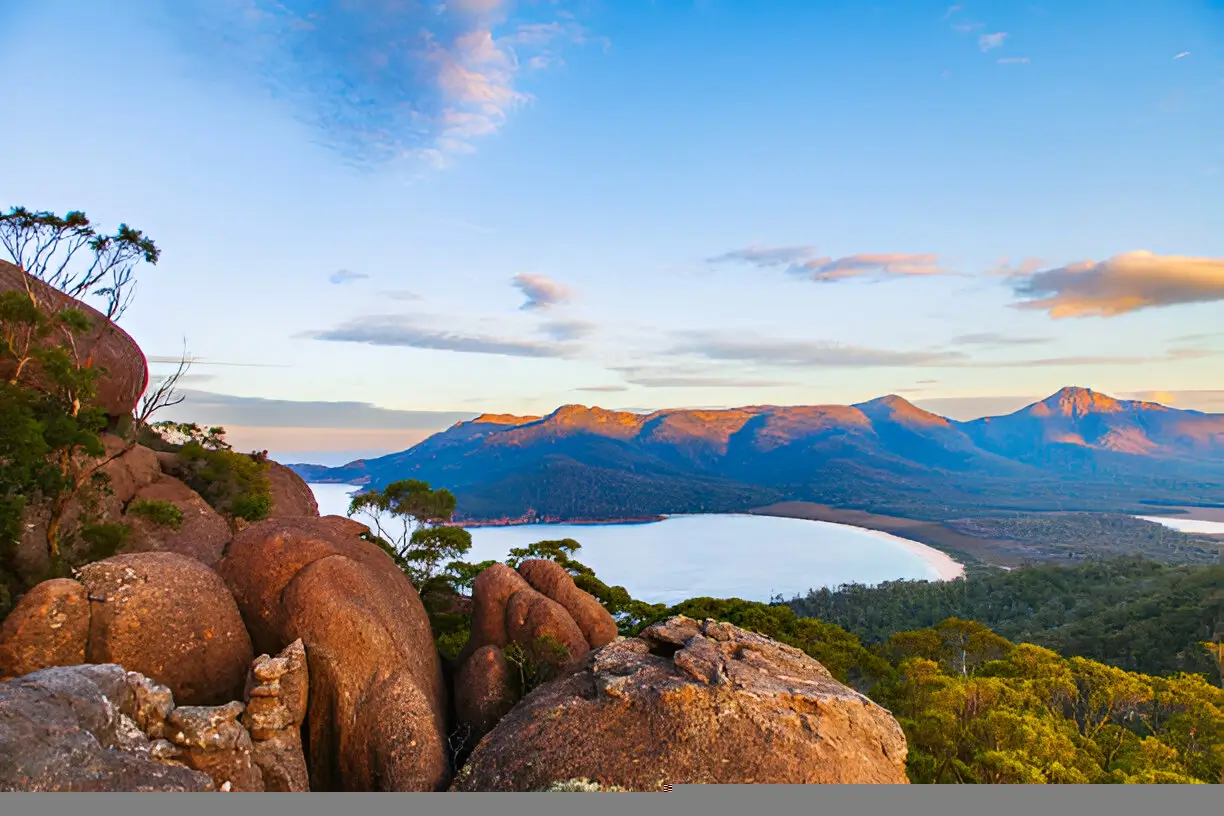Are you interested in learning about the best time to visit Tasmania in Australia? If so, this guide is for you. First, let’s get to know Tasmania.
Known for its rugged landscapes and vibrant festivals, Tasmania’s seasonal shifts create unique opportunities for travellers. Whether chasing sunshine or crisp autumn evenings, timing shapes how you experience the island’s wild beauty.
Summer brings long days perfect for coastal hikes, with temperatures hovering in the low 20s°C. Autumn transforms forests into fiery displays, while winter invites cosy retreats near mountain ranges. Each season unlocks distinct events, from food festivals to outdoor concerts.
As Australia’s southernmost state, this island thrives on contrasts. Coastal trails bloom in spring, and winter markets showcase local produce. Adventure seekers find year-round thrills, while culture lovers dive into art exhibitions and historic sites.
This guide combines climate insights with local expertise. You’ll discover temperature trends, hidden gems, and event calendars to match your interests. Practical tips on packing and regional highlights ensure your trip aligns with Tasmania’s natural rhythms.
Introducing Tasmania: A Land of Diverse Seasons
Before discovering the best time to visit Tasmania in Australia, we need to know about its weather. Tasmania’s ever-changing canvas of natural wonders invites exploration beyond predictable tourist trails.
From frost-dusted peaks to sunlit shores, the island’s microclimates create distinct adventures each season.
Key destinations define Tasmania’s charm:
- Cradle Mountain: Alpine trails sparkle with winter snow, while summer reveals mirror-like lakes.
- Bay of Fires: Orange lichen blazes against turquoise waters, ideal for spring kayaking or autumn camping.
- Port Arthur: Historic ruins gain atmosphere in misty autumn, paired with coastal walks.
The Huon Valley’s apple orchards bloom in pastel shades during September, contrasting with winter’s bare beauty.
Further north, Dark MOFO’s fiery installations and midnight feasts transform Hobart’s coldest months into a celebration of light and warmth.
These contrasts create flexible itineraries. Hikers chase summer sunrises at Cradle Mountain, while foodies explore Huon Valley’s cider routes in spring.
Cultural explorers’ time visit to Port Arthur’s ghost tours or Dark MOFO’s avant-garde performances.
Overview of Tasmania’s Climate and Seasons
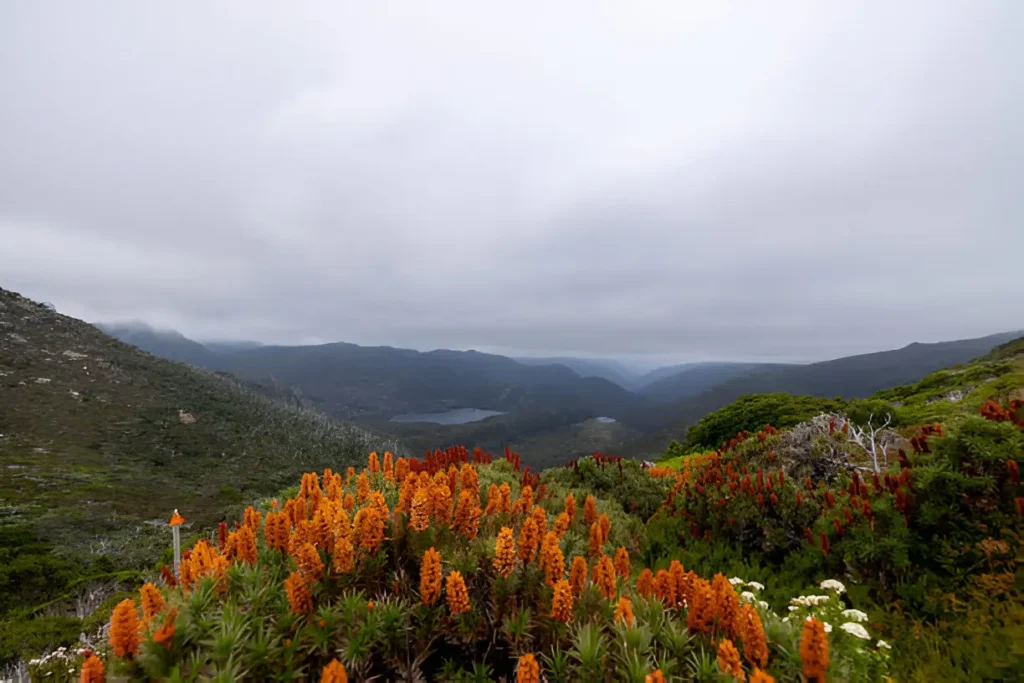
Tasmania’s weather patterns paint a dynamic portrait of nature’s contrasts. Coastal breezes collide with alpine chills, creating microclimates that shift within hours. This unpredictability fuels the local saying: “Don’t like the weather? Wait 20 minutes.”
Understanding Seasonal Variations
Summer days hover around 21-24°C in Hobart, ideal for beachcombing at Binalong Bay. By afternoon, cool southerly winds often sweep in, reminding travellers to layer up.
Winters see temperatures dip to 7°C in the capital, while Cradle Mountain’s peaks wear snow caps from June to August.
Autumn brings stability, with crisp 12-18°C days perfect for hiking the Tarkine rainforests. Spring’s mood swings shine in the Huon Valley, where morning frosts melt into 15°C afternoons amid apple blossoms. Regional differences matter:
- East Coast: Driest area, with 300mm annual rainfall
- Western Highlands: Receives 2400mm yearly, nurturing ancient forests
- Central Plateau – Temperatures drop 5°C lower than coastal zones
Key Climate Facts Across Regions
Hobart’s climate mirrors Mediterranean patterns, while Stanley’s coastal location buffers extreme cold. Compare seasonal averages:
| Location | Summer (°C) | Winter (°C) | Rainfall |
| Hobart | 22 | 11 | 614mm |
| Launceston | 24 | 12 | 666mm |
| Cradle Mountain | 17 | 3 | 1900mm |
These variations let visitors chase sunshine or misty valleys year-round. Pack waterproof layers – mountain showers can strike even in summer hikes.
Discover the Best Time to Visit Tasmania in Australia
Choosing when to explore this island state depends on your priorities. Three factors shape the decision: weather patterns, seasonal events, and preferred activities. Snow enthusiasts target July’s alpine peaks, while festival-goers chase summer’s lively atmosphere.
Warmer months (December-February) deliver 15-hour daylight for coastal hikes and vineyard tours. Tamar Valley’s cellar doors buzz with tastings, and Freycinet’s oyster farms host waterfront feasts. These months suit travellers craving beach days and open-air concerts.
Winter transforms highland regions into snowy playgrounds. Cradle Mountain’s trails become cross-country ski routes, and Hobart’s Dark Mofo festival lights up the solstice with bonfires. Pack thermal layers for frosty mornings, then warm up with whisky tastings by crackling fires.
Key planning considerations for visiting Tasmania:
- Snow depth peaks in August, ideal for alpine adventures
- Autumn’s stable weather suits road trips through wine regions
- Spring whale migrations pair with blooming gardens
Local festivals elevate trips year-round. Huon Valley’s apple harvest (March-April) features cider-making workshops, while winter’s Tasmanian Whisky Week attracts connoisseurs.
Match your itinerary to personal interests – whether chasing powdery slopes or sipping cool-climate wines under sunny skies.
Summer Explorations: Warm Weather and Coastal Adventures
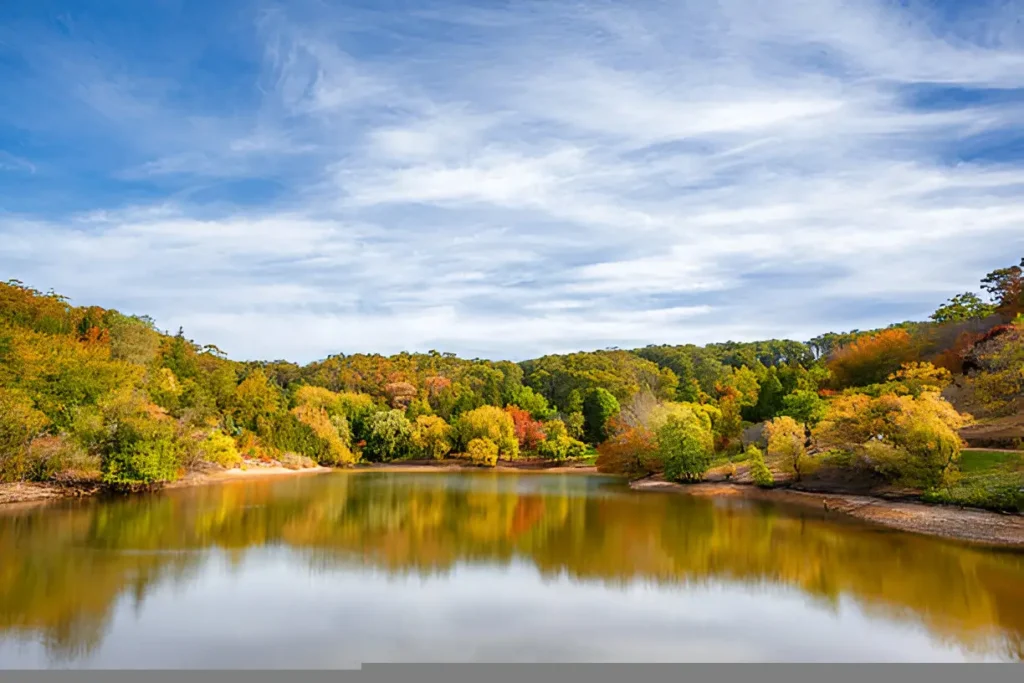
When warmth blankets the island, Tasmania’s beaches come alive with sunseekers and salty breezes. December to February delivers 14-hour daylight for exploring hidden coves and indulging in oceanfront feasts. Coastal trails buzz with energy, while seaside towns showcase their freshest catches.
Outdoor Activities and Coastal Dining
East Coast gems like Freycinet’s Hazards Beach invite leisurely swims and oyster tastings. Meanwhile, the wild West Coast tempts adventurers with South Cape Bay’s windswept walks. Three unmissable summer experiences:
- Bruny Island’s boat tours spot seals beneath towering sea cliffs
- Beachside barbecues featuring grass-fed beef at Binalong Bay
- Kayak fishing expeditions in Mercury Passage’s sheltered waters
Food trucks line Hobart’s docks, serving scallop pies and cool-climate wines. For sunset dining, The Den in Stanley pairs local abalone with panoramic ocean views.
Seasonal Festivals and Market Experiences
Hobart’s waterfront transforms during the Taste of Summer festival. Chefs demonstrate cooking with just-picked berries, while distilleries mix cocktails using native pepperberries. Regional contrasts shine:
- East: Triabunna Market’s seafood paella feasts
- South: Huon Valley’s stone fruit tastings under blossom trees
- North: Launceston’s Jazz Festival with vineyard picnics
Salamanca Market expands its Saturday stalls, offering handmade leather goods beside fresh wasabi-infused cheeses. Evenings bring open-air concerts where folk melodies blend with crashing wave rhythms.
Autumn Adventures: Harvest and Fagus Foliage
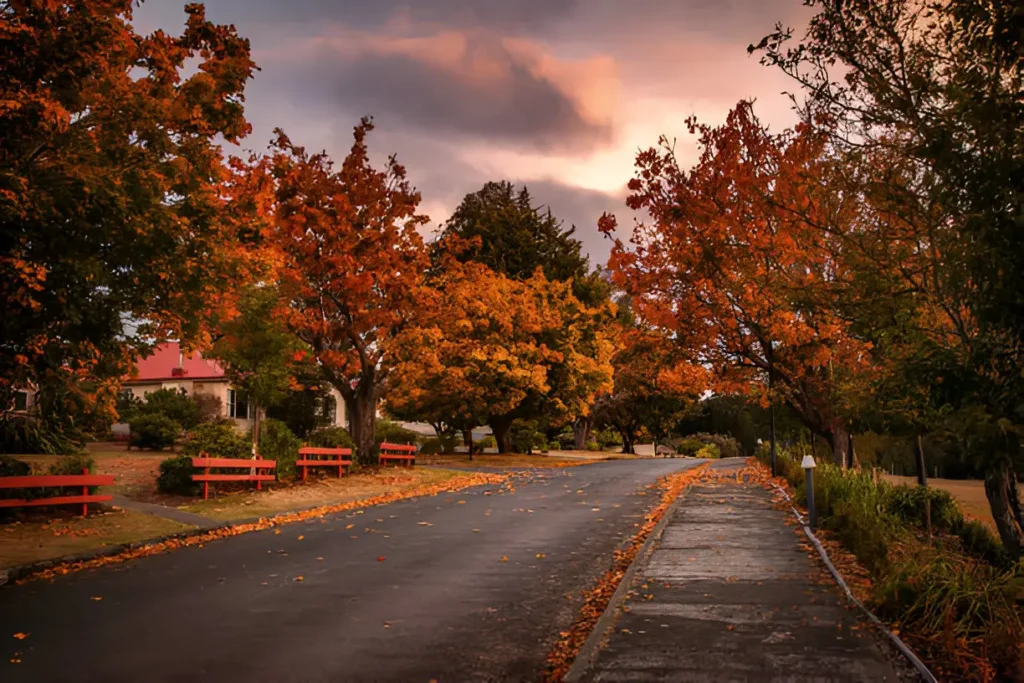
Autumn paints Tasmania in fiery reds and golds, blending crisp air with earthy aromas. Cooler days (10-18°C) create ideal conditions for exploring vineyards and ancient forests. This season draws travellers seeking both gourmet experiences and rare natural spectacles.
Witnessing the Fagus Transition
Deciduous fagus trees transform Tasmania’s alpine zones into a rust-coloured tapestry from late April. Found nowhere else on Earth, these ancient trees shed needles in a two-week display across Cradle Mountain and Mount Field. Rangers lead guided walks explaining this 60-million-year-old survival strategy.
Harvest season energises the island’s culinary scene. Orchards in the Huon Valley bustle with apple-picking, while Derwent Valley farms gather heirloom vegetables. Cellar doors like Josef Chromy offer tastings of newly pressed pinot noir beside crackling firepits.
| Region | Key Activity | Avg Temp (°C) | Peak Month |
| Huon Valley | Apple Harvest | 14 | March |
| Derwent Valley | Fagus Walks | 9 | May |
| Tamar Valley | Wine Blending | 16 | April |
Stable weather patterns make autumn perfect for multi-day hikes. The Overland Track reveals golden grasslands contrasting with evergreen rainforests. Evenings reward explorers with starry skies and hearty meals featuring just-picked produce.
This season’s mix of mild climate and vibrant colours explains its growing popularity. Visitors enjoy crowd-free trails paired with authentic farm-to-table experiences. From foggy morning photography sessions to twilight wine tours, autumn delivers Tasmania’s essence in every crisp breath.
Winter Wonderland: Snow, Festivals, and Fireside Charm
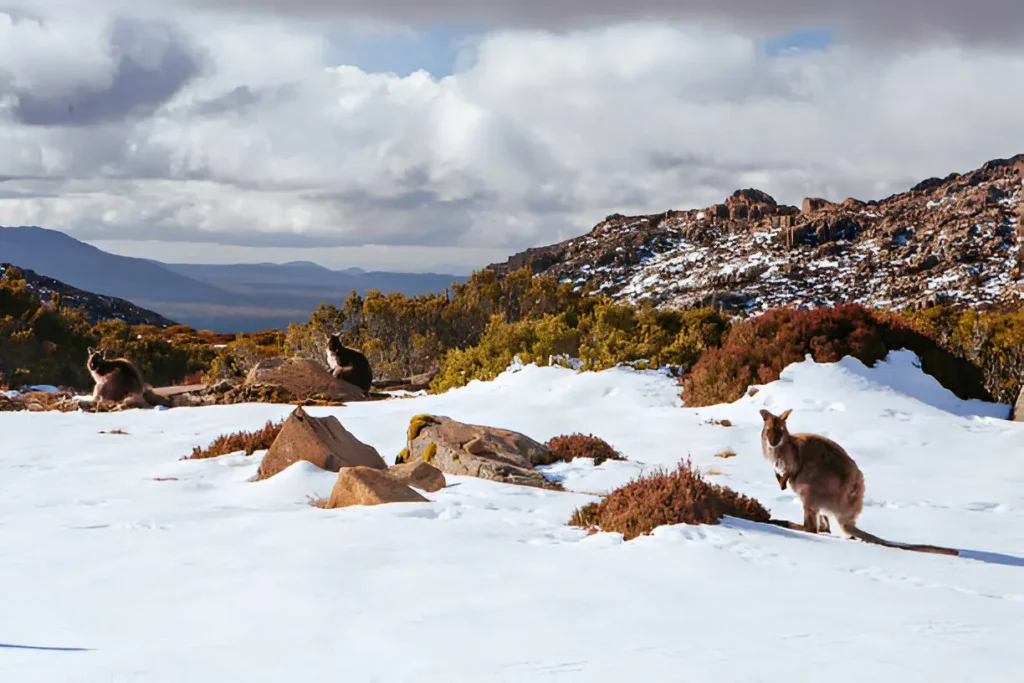
Winter cloaks Tasmania in a serene blanket of frost and festivity. Crisp air sharpens mountain vistas, while valley towns glow with hearth-lit hospitality. This season reveals a quieter side of the island, where misty mornings give way to fiery cultural celebrations.
Snowy Landscapes and Alpine Trails
Cradle Mountain’s peaks wear thick snow mantles from June to August. Cross-country skiers glide through silent forests, while snowshoe trails lead to panoramic lookouts. Mt Wellington’s summit transforms into a playground for tobogganing, with Hobart’s city lights twinkling below.
Alpine huts offer steaming mugs of local cider between adventures. Rangers lead full-moon snow walks, sharing stories of Tasmania’s glacial history. Always pack thermals – temperatures can plummet below freezing during afternoon cloud cover.
Winter Festivals and Cultural Events
Dark MOFO’s avant-garde installations light up Hobart’s darkest nights. Bonfires blaze along Sullivan’s Cove, while the Winter Feast showcases smoked wallaby and leatherwood honey. Over 100 producers gather at Harvest Market, serving whisky-laced hot chocolates and artisan cheeses.
Key winter experiences:
- Night-time photography tours capturing aurora australis glimpses
- Coal River Valley’s truffle hunts with gourmet farm lunches
- Historic theatres hosting acoustic concerts by crackling fires
Roads to highland areas may close during heavy snowfall. Build flexibility into plans – sudden weather shifts often create unexpected magic. This mystical season proves why many consider it a prime period for immersive Tasmanian journeys.
Spring Blossoms: Renewal, Wildlife and Floral Splendour
Spring breathes new life into Tasmania’s wilderness as frost retreats from the valleys. Gardens erupt in colour, while migrating whales breach along coastlines. This season offers a sensory feast – fragrant blooms mingle with salt-sprayed cliffs and budding vineyards.
Blooms, Whales, and Garden Escapes
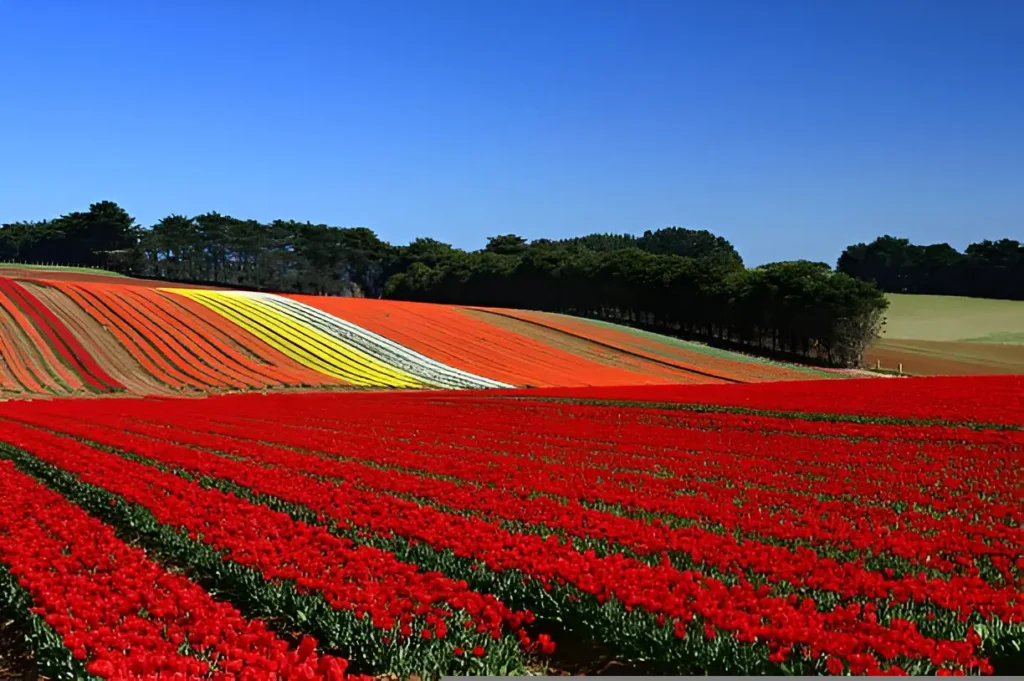
From September, the East Coast becomes a whale highway. Humpbacks journey north, visible from lookout points like Bicheno’s Diamond Island. Join boat tours for closer encounters, often paired with seabird sightings.
Inland, the Royal Tasmanian Botanical Gardens showcase 8,000 plant species. Tulip festivals in Table Cape draw photographers, while native orchids emerge in Mount Field’s rainforests.
Contrast these delicate displays with the West Coast’s rugged charm – wildflowers cling to windswept cliffs near Strahan.
| Region | Spring Highlight | Best Month | Avg Temp (°C) |
| Tamar Valley | Food & Wine Trail | October | 16 |
| East Coast | Whale Watching | November | 18 |
| West Coast | Wildflower Walks | September | 14 |
Tamar Valley’s food scene peaks with asparagus festivals and cellar door lunches. Chefs pair seasonal lamb with just-released rieslings. For active travellers, mild 15°C days allow hiking coastal tracks before afternoon vineyard visits.
Pack layered clothing – sunny mornings can shift to brisk sea breezes. Local guides recommend waterproof boots for exploring fern-lined waterfalls now flowing at full capacity. Spring’s energy makes it ideal for combining nature walks with gourmet discoveries.
Regional Weather Variations and Microclimates
Tasmania’s compact size hides dramatic climate shifts between coastlines and peaks. Coastal cities enjoy temperate conditions, while alpine zones deliver icy surprises. Understanding these contrasts helps travellers pack smart and choose activities wisely.
Coastal Comfort vs Mountain Mystique
Hobart and Launceston rarely see snow, with winter averages around 12°C. Sea breezes moderate temperatures, making coastal national parks like Freycinet ideal for year-round hiking. Sheltered bays let kayakers explore even in cooler months.
Compare this to Cradle Mountain’s alpine climate:
| Location | Winter High (°C) | Summer High (°C) | Annual Snow Days |
| Hobart | 12 | 22 | 1-2 |
| Launceston | 13 | 24 | 0 |
| Cradle Mountain | 3 | 17 | 40+ |
Alpine Adventures Require Preparation
Winter in Tasmania transforms Cradle Mountain-Lake St Clair National Park into a snow realm. June-August brings cross-country skiing and frozen waterfall walks. Always carry chains – roads become icy without warning.
National parks adapt their offerings seasonally. Rangers lead snowshoe tours in July, while summer brings guided rainforest walks. Coastal reserves like Maria Island National Park maintain milder trails year-round.
Check weather apps hourly when moving between regions. A sunny Hobart morning often precedes afternoon snow flurries on nearby peaks. Layered clothing ensures comfort across microclimates.
Tasmania’s Seasonal Events and Festivals
Tasmania’s calendar thrums with year-round celebrations that mirror its shifting landscapes. From summer’s bustling harbours to autumn’s vineyard gatherings, each season offers unique ways to connect with local culture and produce.
Food and Cultural Celebrations
The Taste of Tasmania festival anchors summer’s peak between December and February. Hobart’s waterfront comes alive with chefs shucking oysters beside floating oyster bars.
Over 70 producers showcase cool-climate wines, including rare pinot noirs from the Derwent Valley.
Autumn brings quieter sophistication. Tamar Valley’s Harvest Market celebrates apples and heirloom pumpkins, while Maria Island hosts guided walks pairing wildlife spotting with vineyard picnics.
Cellar doors like Ghost Rock offer blending workshops, perfect for crisp 16°C afternoons.
Local Festivals Across the Year
Regional events highlight Tasmania’s diversity. Dark Mofo’s winter solstice bonfires contrast with spring’s Bloomin’ Tulips Festival in Table Cape.
Maria Island transforms in autumn, offering photography tours amid migrating shearwaters and golden grasslands.
| Season | Festival | Location | Highlight |
| Summer | Taste of Summer | Hobart | Seafood masterclasses |
| Autumn | Huon Valley Mid-Winter Fest | Huonville | Apple Wassailing Rituals |
| Winter | Devil’s Corner Fire Festival | East Coast | Flame-grilled scallops |
These gatherings align with weather patterns and tourist flows. Summer festivals capitalise on long daylight hours, while autumn events leverage stable conditions for outdoor feasts.
Planning around these celebrations deepens connections to Tasmania’s rhythms and communities.
Insider Tips for Planning Your Tasmania Itinerary
Smart preparation unlocks Tasmania’s wild beauty without unexpected hiccups. This island rewards flexible travellers who respect its moody climate and seasonal rhythms.
Local Packing and Weather Readiness
Pack like a pro by prioritising layers. Merino wool base layers work year-round, while waterproof shells handle sudden showers. Essential gear varies by season:
| Season | Must-Have Items | Pro Tip |
| Summer | UV-resistant hat, reef-safe sunscreen | Carry extra water for coastal hikes |
| Winter | Thermal gloves, microspikes for icy trails | Use heated insoles in alpine areas |
| Spring/Autumn | Windproof jacket, quick-dry pants | Pack binoculars for whale watching |
Check weather apps daily – mountain forecasts differ from those of coastal zones. Many parks require bookings for popular attractions like Wineglass Bay.
Booking Advice and Travel Recommendations
Secure accommodation 4-6 months ahead for major events like Dark Mofo. Local guides offer hidden gems beyond crowded attractions. Consider these strategies:
| Booking Type | Lead Time | Insider Advantage |
| National Parks Pass | 2 weeks minimum | Guarantees entry during peak seasons |
| Boutique Lodges | 3-5 months | Early access to farm-to-table dinners |
| Adventure Tours | Flexible last-minute | Local operators adjust for weather changes |
Rent a 4WD if exploring western regions – gravel roads demand sturdy vehicles. Evening ferries to Bruny Island often have spare capacity when morning services sell out.
Conclusion: When is the Best time to visit Tasmania in Australia
From snow-dusted peaks to sunlit vineyards, every month reveals new dimensions of this island’s character. Summer’s coastal festivals contrast with winter’s alpine serenity, while autumn’s golden forests and spring’s whale migrations each tell their own story.
Local events – whether truffle hunts or open-air concerts – align perfectly with nature’s calendar.
Guided tours unlock hidden trails and seasonal delicacies, while self-drive adventures let you chase microclimates at your own pace.
Expert-led tours decode the Tarkine’s rainforest secrets in drier months, while custom itineraries might pair Derwent Valley wines with crisp autumn evenings.
With twelve distinct months of possibilities, strategic planning ensures you catch fireweed blooms or Dark Mofo’s fiery installations.
Check event calendars against weather trends – certain months suit specific adventures better. Local operators offer flexible bookings for sudden weather shifts.
Ready to craft your ideal Tasmanian experience? Start by matching personal interests with regional highlights.
Whether booking a multi-stop tour or designing a road trip, this guide’s insights help align your journey with the island’s natural rhythms. Let Tasmania’s ever-changing landscapes inspire your next adventure.
FAQs on the best season to visit Tasmania
When is the ideal season for hiking alpine trails like Cradle Mountain?
Winter (June–August) brings snow to alpine regions, perfect for snowy landscapes. Summer (December–February) offers warmer conditions for exploring trails without ice.
What months are peak times for food and wine festivals?
January hosts events like Taste of Tasmania, while winter features Dark Mofo. Autumn’s Harvest Festival in the Huon Valley also draws crowds.
How does Hobart’s weather compare to the West Coast?
Hobart has drier summers and mild winters. The West Coast receives more rainfall, creating lush rainforests but cooler temperatures year-round.
When can travellers see Fagus foliage in Mount Field?
Autumn (April–May) showcases golden Fagus displays, particularly in highland areas like Mount Field and Cradle Mountain-Lake St Clair National Park.
Are alpine regions family-friendly during winter?
Yes! Resorts like Ben Lomond offer sledding and beginner slopes. Many lodges have fireside dining, creating cosy experiences for all ages.
What should I pack for spring trips?
Layer with waterproof jackets and breathable clothing. Spring weather shifts quickly, especially in coastal areas like Freycinet National Park.
How early should I book accommodation for summer?
Secure bookings 3–6 months ahead, especially for coastal stays like Bay of Fires or Wineglass Bay. Festivals and holidays increase demand.
Which areas have milder conditions in cooler months?
The Tamar Valley and east coast, including Maria Island, often have sheltered weather. These regions are suitable for winery visits or wildlife spotting year-round.
When do whales migrate near the East Coast?
Humpbacks and southern right whales pass Tasmania’s east coast between September and November, with prime viewing from Eaglehawk Neck.
Are attractions like Port Arthur open in winter?
Yes, though hours may shorten. Winter offers smaller crowds and atmospheric experiences, such as ghost tours at historic sites.

